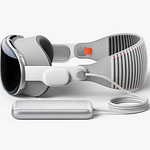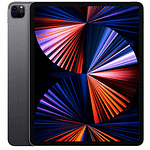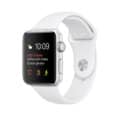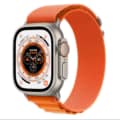- All Apple Devices
- iPad
- Apple iPad Pro 12.9-inch 2017 2nd Gen
Apple iPad Pro 12.9-inch 2017 2nd Gen
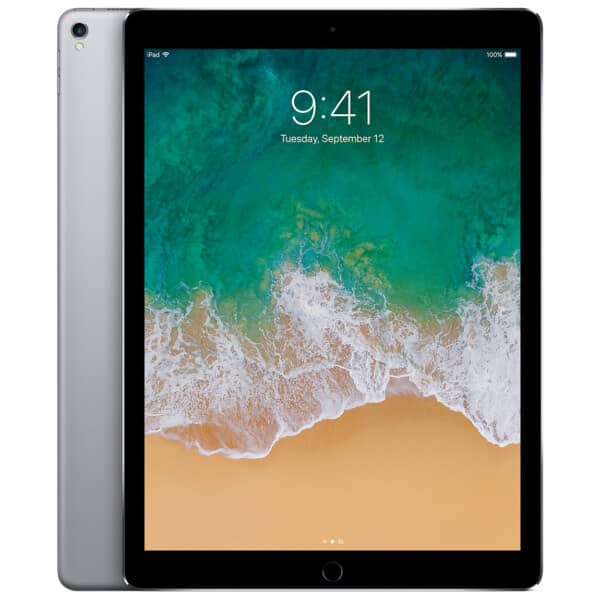
Apple iPad Pro 12.9-inch 2nd Generation
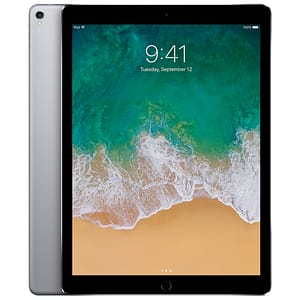
Product Brand: Apple
4.6
Pros
- Large, high-resolution 12.9-inch Retina display with ProMotion technology
- Slim and lightweight design with thin bezels and a sleek profile
- Powerful A10X Fusion chip with M10 motion coprocessor
- Long battery life for all-day use
- Runs iOS 10 (upgradeable to iOS 14)
- Improved 12-megapixel rear camera and 7-megapixel front camera
- Support for Siri and Touch ID
- Available in multiple storage options (64GB, 256GB, 512GB)
- Compatible with the first-generation Apple Pencil and Smart Keyboard
- Supports the Smart Connector for connecting to accessories
- Four-speaker audio for a better sound experience
- True Tone display adjusts color temperature based on ambient lighting
Cons
- No Face ID for secure authentication
- No water resistance or dust protection rating
- No headphone jack (requires a dongle to use wired headphones)
- No support for wireless charging
- Expensive compared to other iPads
- Large size may be difficult to handle for some users
Apple iPad Pro 12.9-inch 2nd Generation Specs, and Features
The Apple iPad Pro 12.9-inch (2017) 2nd Gen is a high-end tablet that was released in June 2017. It features a large, high-resolution display, powerful hardware, and a variety of other advanced features.
Design
The iPad Pro 12.9-inch (2017) 2nd Gen has a sleek and modern design, with an aluminum body that is both durable and lightweight. It measures 305.7 x 220.6 x 6.9 mm and weighs 677 g, making it easy to carry around. It’s available in Silver, Space Gray, and Gold color options.
Display
The iPad Pro 12.9-inch (2017) 2nd Gen has a large 12.9-inch display with a resolution of 2732 x 2048 pixels, which translates to a pixel density of 264 pixels per inch (ppi). The display uses Apple’s proprietary “ProMotion” technology, which allows for a 120Hz refresh rate for smoother scrolling, reduced latency when using the Apple Pencil, and improved overall performance.
Performance
The iPad Pro 12.9-inch (2017) 2nd Gen is powered by the Apple A10X Fusion chip, which features a 64-bit architecture and six cores for enhanced performance. It also has a 12-core graphics processor for improved gaming and graphics-intensive tasks. The tablet runs on the iOS 10 operating system, which can be upgraded to the latest version.
Camera
The iPad Pro 12.9-inch (2017) 2nd Gen has a 12-megapixel rear camera with an f/1.8 aperture, optical image stabilization, and a quad-LED True Tone flash for improved low-light performance. It also has a 7-megapixel front-facing camera with an f/2.2 aperture for selfies and video conferencing.
Other Features
- Touch ID fingerprint sensor for secure authentication
- Four-speaker audio system for improved sound quality
- Apple Pencil support for precise writing and drawing
- Smart Connector for connecting to compatible accessories, such as the Smart Keyboard
- Wi-Fi and Bluetooth connectivity
- Up to 10 hours of battery life
Specifications
Here are the detailed technical specifications of the Apple iPad Pro 12.9-inch (2017) 2nd Gen:
- Display: 12.9-inch IPS LCD, 2732 x 2048 pixels, 264 ppi
- Processor: Apple A10X Fusion chip with 64-bit architecture, M10 coprocessor
- Graphics: 12-core GPU
- RAM: 4 GB
- Storage: 64/256/512 GB or 1 TB
- Rear camera: 12 MP, f/1.8 aperture, OIS, quad-LED True Tone flash
- Front camera: 7 MP, f/2.2 aperture
- Battery: Up to 10 hours of use
- Dimensions: 305.7 x 220.6 x 6.9 mm
- Weight: 677 g
- Colors: Silver, Space Gray, Gold
That concludes our overview of the Apple iPad Pro 12.9-inch (2017) 2nd Gen specs and features. We hope this information is helpful for those interested in purchasing or learning more about this powerful and feature-packed tablet.
Full Technical Specifications
General
| Device Type | Tablet Computer |
| Models |
Also known as the Apple iPad Pro 12.9-inch (2nd generation) Wi-Fi + Cellular & GPS: A1671 (Global); A1821 (China) Wi-Fi only, w/o GPS: A1670 (Global) |
| Announced | 05 June, 2017 |
| Released | 13 June, 2017 |
| Status | Available |
| Predecessor | iPad Pro (1st generation) |
| Successor | iPad Pro (3rd generation) |
| Generation | 2nd |
Design
| Type Design Type called form factor refers to a mobile phone's size, shape, and style as well as the layout and position of major components of phone. There are three major form factors seen in mobile phones => bar phones, folding phones and sliding phones. | Bar |
| Weight | 713 g (1.57 lb) |
| Protection | Scratch-resistant glass, oleophobic coating |
| Colors | Space Gray, Gold, Silver |
Network
| SIM SIM (Subscriber Identity Module) is a small card that contains mobile network subscriber's account information. This allows the phone using the card to attach to a mobile network. The SIM card is most commonly associated with GSM and UMTS mobile networks. Moving a SIM card from one phone to another allows a subscriber to switch mobile phones without having to contact their mobile network carrier. SIM cards can also be used by a phone to store limited amounts of data, such as phone numbers and text messages. | Nano SIM |
Display
| Display Type Display Technology => A number of display technologies and types used in mobile phones => TFT (Thin Film Transistor), IPS (In-Place Switching), OLED (Organic Light Emitting Diode), AMOLED (Active-Matrix Organic Light-Emitting Diode), Super AMOLED (an even advanced version of AMOLED), Resistive Touchscreen (Resistive touchscreens contain two layer of conductive material with a very small gap between them which acts as a resistance), Capacitive Touchsceen (Capacitive touchscreen technology consists of a layer of glass coated with a transparent conductor) | IPS LCD, 120Hz |
| Size | 12.9 inch, 519.2 cm2 (~77.0% screen-to-body ratio) |
| Resolution | 2048 x 2732 pixels, 4:3 ratio |
| Pixel Density Pixel Density (PPI) is refers to the concentration of pixels on a particular display, measured in pixels per inch (ppi). Pixel density is calculated by dividing the diagonal pixel resolution of a display by its diagonal size, higher pixel density better display quality. | 264 PPI density |
| Display Protection Display Protection => Gorilla Glass is a special alkali-aluminosilicate glass shield with exceptional damage resistance that helps protect mobile displays from scratches, drops, and bumps of everyday use, It is always better to go for a smartphone with Gorilla Glass for that added protection and peace of mind. | Scratch-resistant glass, oleophobic coating |
Media
| FM Radio | No |
| Loudspeaker | Yes, with stereo speakers |
| 3.5mm Audio jack | Yes |
Rear/Main Camera
Front/Selfie Camera
Software
| Operating System OS => Every computer system run on a base software called Operating System (OS). Operating System controls all basic operations of the computer (such as smartphone, PDAs, tablet computers and other handheld devices). The Operating System allows the user to install and run third party applications (apps), apps are used to add new functionality to the device. | iOS 10.3.2, up to iPadOS 15.6, planned upgrade to iPadOS 16 |
| User Interface UI or user interface of a device is the look and feel of the on-screen menu system. How it works, its color scheme, how it responds to button presses, all of these things are part of the user interface. | Apple iPad OS |
Hardware
| Chipset Chipset is a group of integrated circuits designed to perform one or a more dedicated functions, often with real time computing constraints, Popular smartphones are equipped with more advanced embedded chipsets that can do many different tasks depending on their programming. | Apple A10X Fusion (10 nm) |
| CPU CPU (Central Processing Unit) mostly known as processors, CPU processes instructions in order to carry out certain functions that make your device operate properly. Processors are often described as the brain of computers, smartphones and tablets, Smartphones and tablets rely on processors to carry out their every task, Processors are an incredibly important factor in selecting any type of computing device, including your smartphone. | Hexa-core 2.38 GHz (3x Hurricane & 3x Zephyr) |
| GPU GPU (Graphics Processing Unit) is a single-chip processor designed to rapidly manipulate and alter memory to accelerate the creation of images in a frame buffer intended for output to a display, This includes things such as lighting effects, object transformations, and 3D motion. | PowerVR Series 7 (12-core graphics) |
| RAM (Memory) RAM (Random Access Memory) is a type of computer memory that can be accessed randomly, any byte of memory can be accessed without touching the preceding bytes that allows information to be stored and accessed quickly from random locations. RAM is the most common type of memory found in computer systems, smartphones, tablets and other electronic devices. | 4 GB |
| Internal Storage Internal Storage is a data storage space (flash memory) mostly used in smartphones, tablets and other electronic devices where operating system, apps, music, photos, videos, files and other user data Is stored. | 64/256/512 GB |
| Card Slot Memory Card Slot is a special slot for inserting a memory card. Memory cards allow you to expand the phone's built-in memory, A memory card (sometimes called a flash memory card or a storage card) is a small storage medium used to store data such as text, pictures, audio, and video, for use on small, portable or remote computing devices such as mobile phones, mp3 players, digital cameras. | No |
| Sensors Sensors are electronic components that detects and responds to some type of input from the physical environment. The specific input could be light, heat, motion, moisture, pressure and location, The output is generally a signal that is converted to use in computing systems, a location sensor, such as a GPS receiver is able to detect current location of your electronic device. | Fingerprint (front-mounted), accelerometer, gyro, compass, barometer |
Connectivity
| Bluetooth Features Bluetooth is a wireless communications technology for exchanging data between mobile phones, headsets, computers and other network devices over short distances without wires, Bluetooth technology was primarily designed to support simple wireless networking of personal consumer devices. | 4.2, A2DP, EDR |
| Infrared Infrared connectivity is an old wireless technology used to connect two electronic devices. It uses a beam of infrared light to transmit information and so requires direct line of sight and operates only at close range. | No |
| Wi-Fi Wi-Fi is a popular wireless networking technology using radio waves to provide high-speed network connections that allows devices to communicate without cords or cables, Wi-Fi is increasingly becoming the preferred mode of internet connectivity all over the world. | Wi-Fi 802.11 a/b/g/n/ac, dual-band, hotspot |
| USB | Lightning, USB 3.0; magnetic connector |
| GPS GPS The Global Positioning System is a satellite-based radio navigation system, GPS permits users to determine their position, velocity and the time 24 hours a day, in all weather, anywhere in the world, In order to locate your position, your device or GPS receiver must have a clear view of the sky. | Yes, with A-GPS, GLONASS (Wi‑Fi + Cellular model only) |
| NFC NFC (Near field communication) is a set of standards for smartphones and similar devices to establish peer-to-peer radio communications with each other by touching them together or bringing them into proximity, usually no more than a few inch. | |
| HDMI HDMI (High-Definition Multimedia Interface) is a compact audio/video interface for transferring uncompressed video data and compressed or uncompressed digital audio data from a HDMI-compliant source device to a compatible computer monitor, video projector, digital television, or digital audio device. | No |
Battery or Power
| Battery Type Battery Type => Cell phones run on various kinds of batteries depending on the manufacturer, phone size or shape and features. There are basically four types of cell phone batteries => Lithium Polymer, Lithium Ion, Nickel Metal Hydride and Nickel Cadmium. | Li-Ion (Lithium Ion) |
| Capacity Battery Capacity is a measure (typically in Amp-hr) of the charge stored by the battery, and is determined by the mass of active material contained in the battery. The battery capacity represents the maximum amount of energy that can be extracted from the battery under certain conditions. | 10,891 mAh, (41 Wh) |
| Placement | Non-removable |
Disclaimer Note
We can not guarantee that the information on this page is 101% correct.

